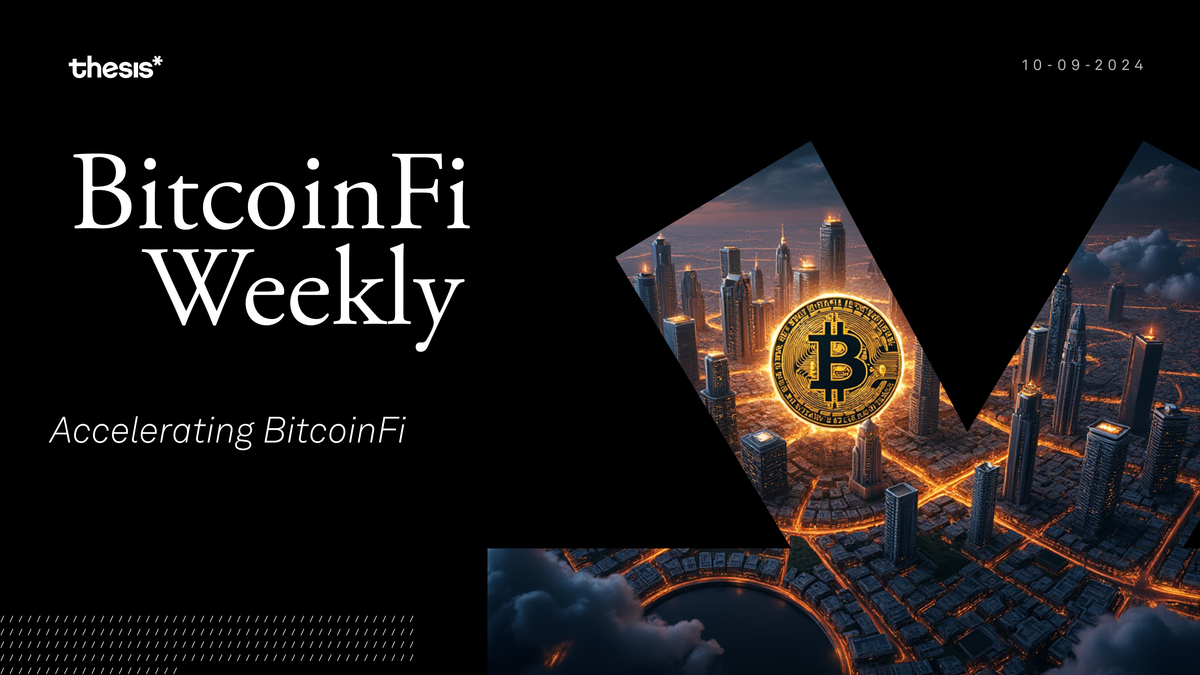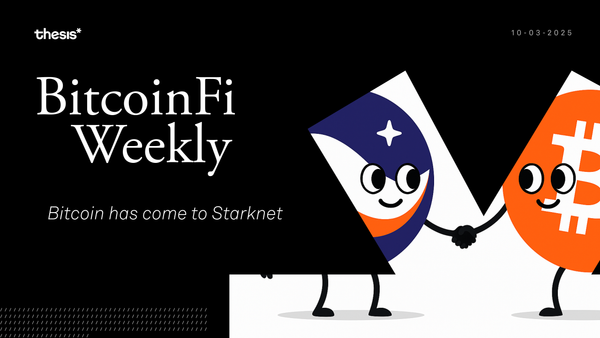Accelerating BitcoinFi
Here's to the crazy ones. The misfits. The rebels. The troublemakers. The round pegs in the square holes of traditional finance. The ones who see things differently. They're not fond of rules. To you, the unhinged visionaries, the BitcoinFi Accelerator calls.

Welcome to BitcoinFi Weekly. We cover where people use their BTC and what is changing in the Bitcoin world.
Welcome to Q4, where we are starting off immediately with a week of chaotic headline distractions, where the noise drowns out the real signals. Case in point: the latest claim that Peter Todd is Satoshi Nakamoto, showcased in an HBO documentary—a mess of half-truths and speculation, thrown together like a drunk fumbling with a Rubik's cube in the dark. It’s the kind of media fluff that keeps eyes glued to the mystery of Bitcoin's past while ignoring its present—and, more importantly, its future.
And while they’re out there chasing ghosts, we’re here focused on what matters. In this edition of BitcoinFi Weekly, we’re diving into the big moves shaping the ecosystem right now: from tBTC making waves on Compound, to Babylon Protocol's TVL explosion, to Bitcoin covenants being shoved down PIPEs, we got all the signals covered.
Here’s this week’s rundown:
⚡️ Feature Piece: Accelerating BitcoinFi
🌪️ Babylon Season 2 Brings Wave of TVL
🧩 Bitcoin PIPEs: Covenants and ZKPs on the Bitcoin L1 without Soft Fork
🌀 Solv introduces the Staking Abstraction Layer
🏦 tBTC Proposed as Collateral on Compound
🔍 LayerEdge introduces Verification Layer
Feature Piece: Accelerating BitcoinFi
While the buzz around HBO’s latest “documentary” (if you can call it that) on Satoshi Nakamoto lit up the headlines, anyone who’s spent a modicum of time in Bitcoin knew it was little more than noise. The drama, the theories—it all felt like a distraction. Sure, there’s a certain allure to unraveling the enigma of Bitcoin’s creator, but the real story isn’t in the past. It’s in the present. The present, where developers are building on Bitcoin in ways Satoshi could have never imagined possible.
The Bitcoin builders of today are less concerned with who started Bitcoin and more focused on its future. To streamline and catalyze this energy, the BitcoinFi Accelerator was launched. The BitcoinFi Accelerator is designed to provide early-stage startups with the resources, mentorship, and funding necessary to build applications on Bitcoin or EVM-compatible networks. Selected participants will receive $150,000 in initial funding in exchange for 5% equity. The program runs intensively for six weeks, from November 4th to December 13th, 2024, with ten teams chosen for the inaugural batch.
The BitcoinFi Accelerator Core Focus Areas
The accelerator's mission focuses on three primary sectors within the Bitcoin ecosystem. First, the program targets infrastructure projects to enhance Bitcoin's speed, efficiency, and developer tools. This includes projects such as bridges, node software, oracles, and decentralized storage solutions. The accelerator is particularly interested in projects developing tools like developer SDKs, DePin solutions, and interoperability protocols.
The second area of focus is DeFi, where the accelerator seeks to expand Bitcoin’s footprint across all chains. This encompasses many projects, from DEXs and AMMs to lending platforms, yield farming protocols, and stablecoin mechanisms.
The third sector, SocialFi, aims to drive Bitcoin adoption through social and consumer applications. These include decentralized social networks, content creation platforms, social tokens, creator economies, and decentralized identity solutions. Projects in this category will focus on showcasing Bitcoin's benefits to everyday users and expanding its utility beyond simple payments.
Key Benefits for Participants
The BitcoinFi Accelerator provides substantial value for early-stage teams through financial backing, mentorship from industry leaders, and critical go-to-market support. Here’s what participants can expect:
- Investment: Each startup accepted into the BitcoinFi Accelerator receives $150,000 in upfront funding in exchange for 5% equity. This isn’t a one-off. Successful participants will also have access to follow-on funding from a broad network of top-tier investors.
- Mentorship & Engineering Support: The accelerator is partnered with some of the most recognized names in Bitcoin. From Tim Draper and Muneeb Ali to Matt Luongo and Domo, founders will gain access to a wide range of mentors who understand Bitcoin and have successfully built Bitcoin-based businesses. Engineering support is also provided.
- Go-to-Market Strategy & Networking: One of the most significant barriers for early-stage startups is scaling their ideas from concept to a market-ready product. The BitcoinFi Accelerator gives founders the tools they need to take their projects to market. More than just connections to investors, participants will have the opportunity to build networks within the Bitcoin ecosystem, making it easier to gain traction and visibility.
Application Details and Selection Process
If you’re an early-stage startup with a working demo or MVP, and your team is ready to focus full-time on building the future of Bitcoin, the BitcoinFi Accelerator could be your ideal launchpad.
- Applications are open from September 27th to October 23rd.
- Selection phases will occur from October 23rd to October 29th. Finalists will be chosen after interviews and a pitch presentation to the selection committee.
- The first cohort kicks off on November 4th, running until December 13th.
This is a unique opportunity to join a tightly curated group of builders. Apply here now.
BitcoinFi Updates
Babylon Season 2 Brings Wave of TVL
Today, Babylon Protocol’s cap 2 (second deposit round) saw an increase in BTC deposits skyrocket from 1,000 to nearly 23,891 BTC—a staggering 2289.1% rise. This pushes Babylon’s TVL to just under $1.5 billion, positioning it as the third-largest restaking platform, behind Symbiotic and EigenLayer.
Lombard Finance is among the top beneficiaries of this round. The top five Liquid Staking and Restaking protocols accounted for 17.4k BTC, with Lorenzo Protocol seeing the largest single-day jump of 4,561 BTC in deposits.
The latest round introduced a time-limited deposit window of 1.5 hours. This helped mitigate the transaction fee spikes seen in the first round, where fees reached $500. Still, many users opted for liquid restaking protocols like Lombard Finance and PumpBTC, which captured nearly 70% of the deposits, signaling strong demand for LRTs.
Despite the number of participating addresses decreasing from 18,000 to 12,000, deposit volumes soared. The new deposit cap of 500 BTC allowed bigger players to enter, but concerns about centralization remain, with the top 10 operators controlling 86% of funds.
Bitcoin PIPEs: Covenants and ZKPs on the Bitcoin L1 without Soft Fork
Functional encryption (FE) has emerged as a promising tool for enhancing Bitcoin's capabilities, particularly in enabling covenants and zero-knowledge proof verification without altering the underlying protocol. FE allows for the decryption of messages while simultaneously computing functions on them, opening up new possibilities for conditional spending of Bitcoin UTXOs.This concept relies on creating a "tweaked" signing key that only signs messages if specific conditions are satisfied. It works with existing Bitcoin cryptography, such as Schnorr and ECDSA. Without additional opcodes, this approach effectively implements covenants, allowing more programmable transactions on Bitcoin, from escrow-like functions to conditional spending.
However, implementing FE for Bitcoin faces significant challenges. FE is computationally intensive, necessitating multi-input function-hiding capabilities and support for arbitrary circuits. Current efficient implementations rely on Indistinguishability Obfuscation, a cryptographic method that makes a program unreadable while still allowing it to function, ensuring that even if someone has the program's code, they can't understand how it works. While theoretically feasible, it lacks practical efficiency.
A proposed solution involves using Polynomial Inner Product Encryption (PIPE)-based SNARKs, specifically the Placeholder proof system, to enable ZKP verification on Bitcoin. This method aims to emulate absent covenant opcodes and introduce new verification mechanisms using the Bitcoin PIPEs framework. This approach could overcome current Bitcoin Script limitations by generating unique keys and signatures that are conditionally valid based on specific proof conditions.
While FE is still in its early stages, it has significant upside. We will be monitoring it and provide updates in the coming weeks.
Solv Introduces the Staking Abstraction Layer
Solv Protocol has introduced the Staking Abstraction Layer (SAL), a new framework designed to simplify and standardize Bitcoin staking across different blockchain networks. SAL's primary goal is to abstract the complexities of Bitcoin staking, allowing users to stake their BTC seamlessly across different networks. By addressing the technical aspects of cross-chain staking, SAL provides a simplified way for BTC holders to onboard to BitcoinFi.
As part of the broader SAL initiative, Solv Protocol has launched several BTC staking products, showcasing how the framework can be used to generate yield across different networks:
- SolvBTC.BBN: Used for Bitcoin re-staking on Babylon.
- SolvBTC.Core: Aimed at securing the CoreDAO network.
- SolvBTC.Ethena: Leveraging basis trading strategies with Ethena Labs.
By placing SAL at its core, Solv is positioning itself quite nicely as a leader in BitcoinFi innovation.
tBTC Proposed as Collateral on Compound
Compound Finance is considering adding tBTC as collateral. This proposal is huge for BitcoinFi, expanding Bitcoin's utility within the greater DeFi landscape.tBTC is a decentralized wrapped Bitcoin token that maintains a 1:1 backing with native BTC. Unlike other wrapped Bitcoin tokens, tBTC's backing is not held by a central intermediary but instead secured by a decentralized network of nodes using threshold cryptography. This approach aims to minimize trust requirements and allows for direct redemption to native BTC without relying on a centralized custodian.
Since its full 2-way BTC bridge launch in August, tBTC has expanded to nine chains beyond Bitcoin and has seen its market capitalization grow from $85 million to $225 million in just three months. It's already being used as collateral for crvUSD and is set to go live on Aave, another major DeFi protocol.
Adding tBTC as collateral on Compound Finance would provide Bitcoin holders with new ways to generate yield and introduce a truly decentralized BTC-backed asset to Compound’s pool of assets. This would enhance trust minimization in Compound’s stack and attract a larger user base by offering preferable yields through the Threshold Network’s incentive program.
LayerEdge introduces Verification Layer
LayerEdge is a new project that aims to leverage Bitcoin's security to enhance the security of the ZK economy.LayerEdge builds upon the work of Babylon, which has already extended Bitcoin's security to benefit PoS chains. LayerEdge aims to take this concept further by applying it to the ZK ecosystem.
The value proposition of LayerEdge is twofold:
- It aims to serve as a power hub for ZK Protocols by leveraging Bitcoin's Proof-of-Work security.
- It seeks to enhance the security of ZK chains without compromising their autonomy by anchoring their computational power and verifiability in Bitcoin's robust security model.
LayerEdge's architecture is designed to support various types of proofs via a general prover. These proofs are stored in a data availability layer, like Nubit, and then aggregated. The final aggregated proof is settled on Bitcoin, allowing LayerEdge to amortize the cost of settling on Bitcoin and distribute its security among all participants.
Key components of LayerEdge include:
- An Aggregation Module that combines multiple zk-proofs into a single batch, reducing verification costs.
- Support for various use cases, including:
- Identity & Privacy protocols
- Cross-Chain Applications
- On-Chain Gaming
- Supply Chain & Data Provenance
LayerEdge aims to enhance the security of ZK protocols and applications by leveraging Bitcoin as a trust anchor through Babylon’s methodology. By acting as a hub that connects ZK protocols to Bitcoin's Proof-of-Work consensus, LayerEdge enables a new level of security and trust for decentralized applications across various sectors.
Closing Thoughts
As the sun sets on another week in the relentless march of BitcoinFi, we find ourselves standing on the precipice. While the headlines chase shadows, the real action is happening in the hands of those pushing the boundaries of what Bitcoin can be. Here's to the crazy ones. The misfits. The rebels. The troublemakers. The round pegs in the square holes of traditional finance. The ones who see things differently. They're not fond of rules. And they have no respect for the status quo. You can quote them, disagree with them, glorify or vilify them. About the only thing you can't do is ignore them. Because they change things. They push the Bitcoin ecosystem forward. And while some may see them as the crazy ones, we see genius. Because the people who are crazy enough to think they can change the world are the ones who do.
To you, the unhinged visionaries, the BitcoinFi Accelerator calls. $150,000 in seed money and a shot at contributing to the greatest ecosystem onchain. Applications are open until October 23rd. Got a working demo that isn't held together with duct tape and prayers? An MVP that actually functions? Apply now!
Thank you for tuning in to this week’s BitcoinFi Weekly. See you next week.
If there's a topic you’d like us to cover or have questions, reach out at [email protected].
Learn more about Mezo at the following channels:
👾 Discord: https://discord.mezo.org
🕊 X: https://twitter.com/MezoNetwork
🖥 Website: https://mezo.org
🏦 Deposit Portal: https://mezo.org/hodl
ℹ️ Docs: https://info.mezo.org





